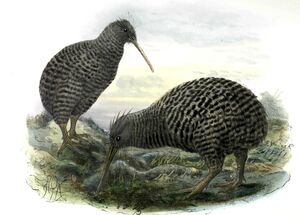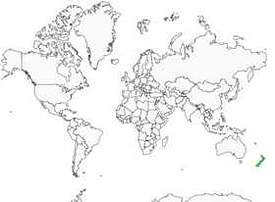Little Spotted Kiwi
Apteryx owenii - Kiwi d'Owen
Identification
The Little Spotted Kiwi is an endemic species of New Zealand. It is the smallest of five kiwi species and has only stubs of wings, not a tail. Nocturnal and difficult to observe, however it can be heard. It has a light brownish-gray colour which is finely marbled with light horizontal stripes, a pale beak, pale tarsi and strong toes armed with claws. It could be mistaken for an immature North Island Brown Kiwi, but the latter has dark tarsi and toes, as well as a darker plumage.
Subspecific information monotypic species
Foreign names
- Kiwi d'Owen,
- Kiwi moteado menor,
- kiwi-malhado-pequeno,
- Zwergkiwi,
- kis foltos kivi,
- Kleine Grijze Kiwi,
- Kiwi macchiato minore,
- mindre fläckkivi,
- Dvergkivi,
- kivi pásikavý,
- kivi malý,
- Dværgkiwi,
- pikkukiivi,
- kiwi tacat petit,
- kiwi mały,
- Малый киви,
- コマダラキーウィ,
- 小斑几维,
- 小斑鷸鴕,
Voice song and call
The male emits a song which sounds like a repeated, ascending whistle, the female's song is slower, softer and interrupted by chirps and whistles; he occasionally sings in the evening to mark his territory and stay in touch with his partner; often couples sing together, it's a repetition, the calls happen from 25-35 times per sequence of song.
Habitat
It was commonly found in the forest and scrublands on the North and South Islands. Little Spotted Kiwi (Kiwi d'Owen) was especially common.
Behaviour character trait
The Little Spotted Kiwi is unable to fly. It is nocturnal, during the day it rests in a burrow, a crevice of rock, a hollow tree trunk, or under thick vegetation, emerging shortly after dusk. It feeds like other species by walking slowly and tapping the ground, when prey is detected it probes the leaves with its beak. Highly elusive, it is a very territorial bird which fights violently with its fellow birds with sharp claws and talons, leaving behind a multitude of feathers on the ground.
Flight
He doesn't fly, it's a flightless bird. Its wings are just stubs of a few centimeters long.
Dietfeeding habits
The Little Spotted Kiwi mainly feeds on small invertebrates, particularly earthworms, beetle larvae, cicadas, flies and mites. It also feeds on spiders, adult insects, fallen small fruits and leaves.
Reproduction nesting
Eggs are laid from July to January. The nest is often a short burrow, a hollow tree trunk, or set up on the ground beneath dense vegetation. The size of clutches ranges from 1 to 2 large white eggs. Incubation is only performed by the male. Incubation is estimated to be 65 to 75 days. The stay at the nest is from 4 to 5 days. The juveniles return during 2 to 4 weeks, and then become independent. They are mature at 3 years of age and are then able to reproduce. Juveniles do not disperse more than 3.5 km.
Geographic range
At the time of European colonisation, the Little Spotted Kiwi had almost disappeared from the North Island, with only one specimen collected (Mt. Hector, Tararua Range, 1875) and another reported near Pirongia in 1882. The species was still present in the regions of Nelson, Westland and Fiordland until the early 1900s, but gradually disappeared, leaving a small relict population on Urville Island. It is believed that five Little Spotted Kiwis were introduced to Kapiti Island in 1912, and they thrived there. Since 1983, birds have been transferred from Kapiti to the Hen, Tiritiri Matangi, MoTuihe, and Red Mercury Islands in an attempt to establish and reproduce this species.
Threats - protection
IUCN conservation status
concern
in the Wild
threatened
evaluated
Once widespread on both the main islands, it is now restricted to a few islands and sanctuaries of the mainland. The Little Spotted Kiwi had disappeared from the North Island by the late 1800s, likely due to predation by dogs. Declines and disappearances in the South Island are likely linked to predation by introduced mustelids, dogs, and cats. Fortunately, some birds had been introduced to Kapiti Island in 1912 and have prospered there despite the presence of the Weka. Introductions to other mainland sites without predators have also been largely successful. Like its relatives of the same family, it is a highly sensitive species to predation by introduced predators, particularly dogs. IUCN Status Near Threatened.
Sources of information
- IOC World Bird List (v14.2), Gill, F and D Donsker (Eds). 2024-04-18.
- Handbook of Australian, New Zealand and Antarctic birds, 1: ratites to ducks., Marchant, S.; Higgins, P. J.
- Know your New Zealand Birds, Lynnette Moon
- The field guide to the birds of New Zealand., Heather, B. D.; Robertson, H. A.
- The State of New Zealand's Birds 2005., Wilson, K-J.
- Vol. 1 - Handbook of the Birds of the World, Josep del Hoyo-Andrew Elliot-Jordi Sargatal
- xeno-canto, Sharing bird sounds from around the world,
- ARKive, Christopher Parsons
- Avibase, Lepage Denis
- Conservation-comments-NZ,
- HBW Alive,
- New Zealand birds and birding, Narena Olliver
Other sources of interest
 Specification sheet created on
31/07/2023 by Yann Cambon
Specification sheet created on
31/07/2023 by Yann CambonTranslation by AI Oiseaux.net
© 1996-2025 Oiseaux.net
- Accipitriformes
- Aegotheliformes
- Anseriformes
- Apodiformes
- Apterygiformes
- Bucerotiformes
- Caprimulgiformes
- Cariamiformes
- Casuariiformes
- Charadriiformes
- Ciconiiformes
- Coliiformes
- Columbiformes
- Coraciiformes
- Cuculiformes
- Eurypygiformes
- Falconiformes
- Galliformes
- Gaviiformes
- Gruiformes
- Leptosomiformes
- Mesitornithiformes
- Musophagiformes
- Nyctibiiformes
- Opisthocomiformes
- Otidiformes
- Passeriformes
- Pelecaniformes
- Phaethontiformes
- Phoenicopteriformes
- Piciformes
- Podargiformes
- Podicipediformes
- Procellariiformes
- Psittaciformes
- Pterocliformes
- Rheiformes
- Sphenisciformes
- Steatornithiformes
- Strigiformes
- Struthioniformes
- Suliformes
- Tinamiformes
- Trogoniformes




